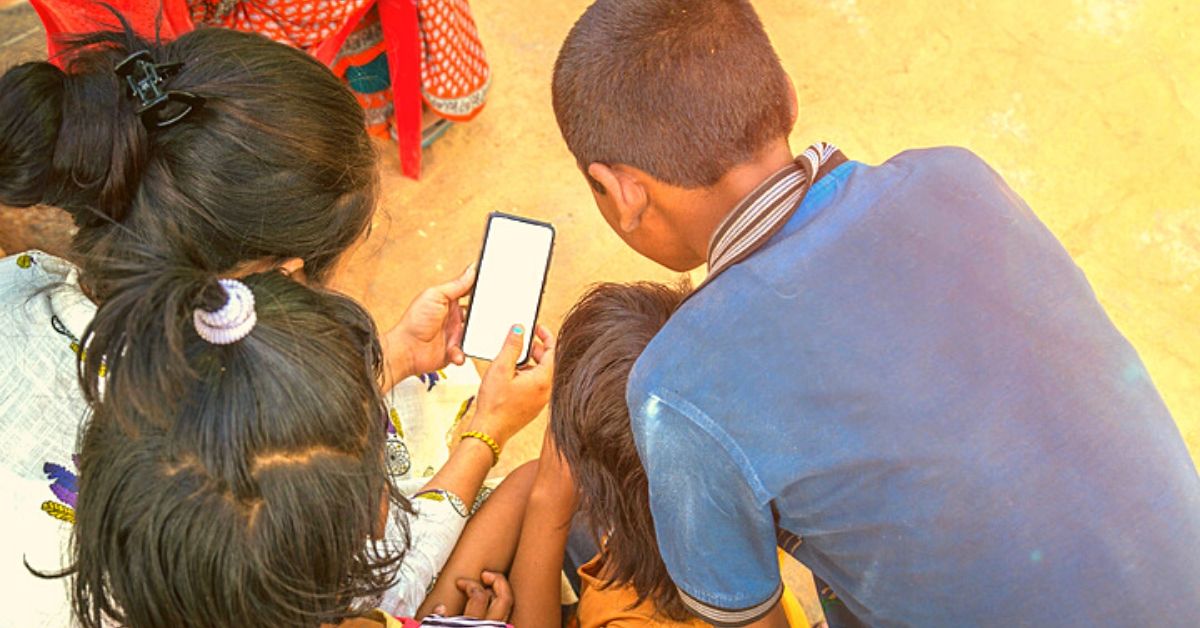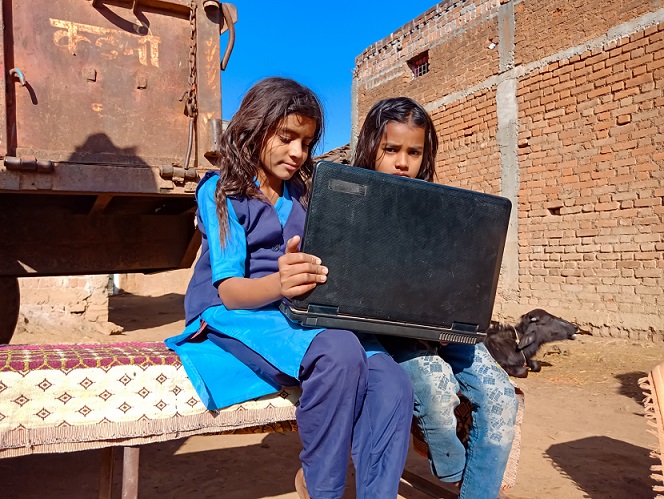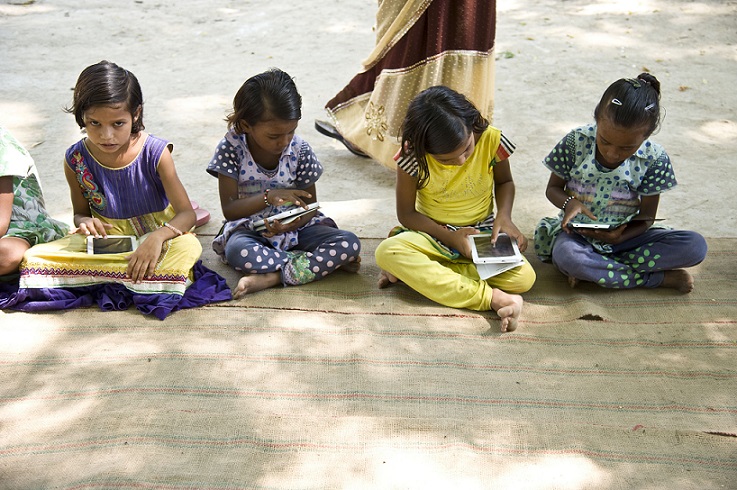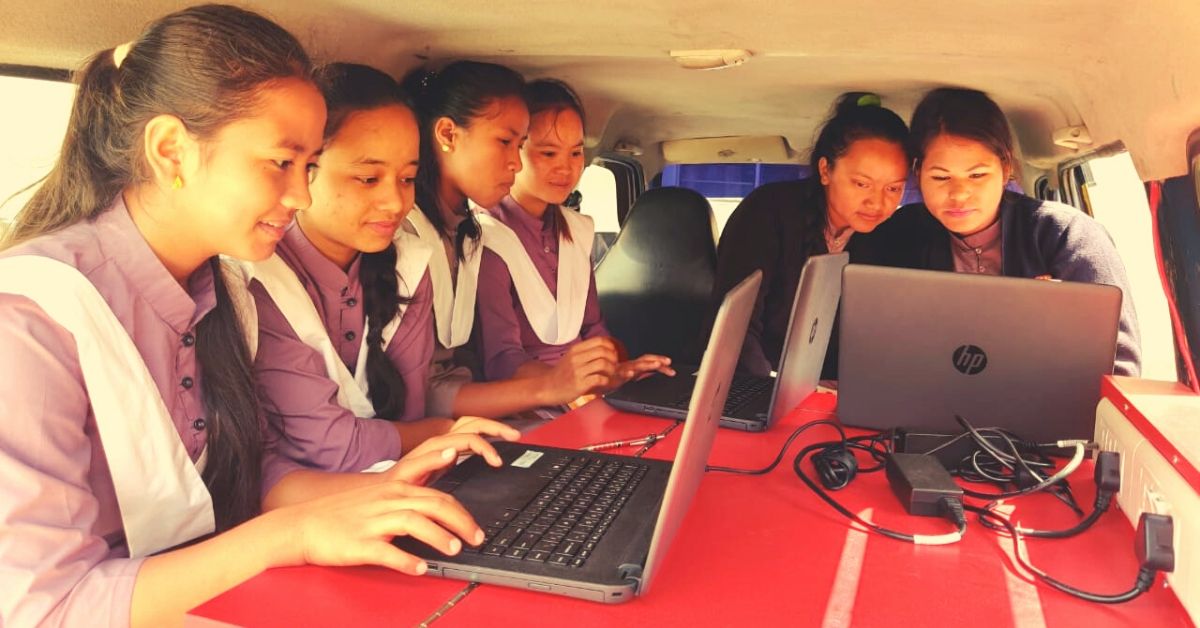Classes Online? What About Those Who Share A Basic Phone Among a Family of 5?
Also, what about places where there is no internet? Despite a large base of internet users, the internet penetration rate in the country stands at just nearly 50% in 2020.

A couple of weeks ago, a science teacher in a government school forwarded me an apology message he had received from a student of Class 8 on WhatsApp. Her father’s smartphone had run out of battery and data, and she was submitting her worksheet a day late.
When I asked the school teacher whether the student was making up excuses, he shot it down. The student was one of the most diligent in class, he said. There was no way she was making up excuses.
Massive User Base, but Digital Divide Remains
India has the second largest internet user base in the world with over 630 million subscribers.
It also has the cheapest mobile data prices in the word. This has allowed vast swathes of our population to access the internet in the last few years.
“The average internet user now consumes more than 9GB of data per month. That translates to watching 16 hours of video a month compared to just 15 minutes in 2015,” notes Smriti Parasheera, a technology policy researcher with the National Institute of Public Finance and Policy, in her column for the BBC.
Despite this, the internet penetration rate in the country stands at only 50% in 2020, according to Statista.
“Even though 66% of the country’s population lives in its villages, rural internet density is just 25.3. In comparison, urban areas have a significantly higher density of 97.9,” adds Smriti, citing data released by TRAI. These numbers cite the number of internet subscribers per 100 people in the population.
Access to the internet in India depends on a myriad of factors including human development indicators, geography, income and of course, gender. According to 2019 report by GSMA, a body representing mobile operators in India, a mere 16 per cent of Indian women were using mobile and internet services.
Although data is cheap compared to global prices, the cost of internet-enabled devices remains a barrier. Additionally, the Central government’s project to provide broadband internet connectivity to India’s 250,000 gram panchayats, which started in 2011, has only reached the halfway stage.

Limitations of Online Education
While students in urban private schools from middle and high income households had little trouble accessing the internet and attending online classes on platforms like Google Meet during the lockdown, those from low-income neighbourhoods studying in both government and private institutions don’t have the same sort of luxury.
Speaking to The Better India, Smruti Savkur of Saarthi Education, a New Delhi-based non-profit working with 6,000 families across seven low-income communities, spoke of the challenges of online education during the current lockdown.
“In low-income communities, the first thing is to realise that there is often one smartphone in the family being shared among many. So, if there are three children in the house, all of them are dependent on the same smartphone for their education. And apart from children, parents/other members have their own things that they want to do on their phones,” she says.
The second concern is low bandwidth and recharge problems. Those facilitating education cannot send material that is going to consume a lot of data and requires families to recharge in the way that we do. They have very low data quantity, and also the areas that they live have low connectivity or bandwidth.
“Also, you can send content online but unless it is something very concrete and tangible, it is challenging to sustain the child’s interest in that or get any learning out of it because they are used to learning a certain way,” she says.
According to a recent survey conducted by Centre for Budget and Policy Studies of 733 students (253 boys and 480 girls in Class 7 and 8) studying in ten government schools in Patna and Muzaffarpur districts in Bihar, “202 (28%) had no phone and 154 (21%) could not be reached as the number was not operational.”
“Of these, 277 (38%) had smartphones and 114 (16%) had other phones. A higher percentage of boys (36%) had access to smart phones as compared to girls (28%)…Additionally, in almost 95% of the 277 cases where families had a smartphone, the device belonged to a male member and that meant it was not always accessible to children, this being truer for girls than for boys,” the study said.
The study went onto add that during the lockdown, girls are subject to a disproportionate burden of household chores and little control over how they spend their time, thus restricting the opportunities to even watch TV channels when educational programmes are being aired.

Solutions
1) Technology-Enabled Learning
To address these structural imbalances in how low-income communities accessed online education for their children from age 3 to 11, Saarthi Education leveraged their model of parent engagement to find solutions. As stated in this article, the model includes what are known as ‘relationship managers.’
These are women from the same community, who are either mothers or young graduates and trained in early childhood content, parenting and counselling, and are assigned families in the area to whom they provide support through calls and home visits. Currently, these sessions are done over calls and WhatsApp.
“The same relationship managers were still catering to the same 30 families each they were catering to earlier. What they are doing now is they send one worksheet to the child every single day over WhatsApp. Now the worksheet is designed very simply keeping in mind that WhatsApp is going to be used as a delivery platform, but the actual learning is not going to happen on the device,” says Ankit Arora, Founder and CEO of Saarthi Education.
Every morning between 9.30 and 10 am, the relationship manager sends a worksheet in a .jpeg format to the child who copies it out either by themselves or with the assistance of one of the parents. The child completes the worksheet, taking their parent’s help wherever required, following which they take a picture of the completed worksheet and send it back to their relationship manager.
When the relationship manager receives the completed worksheet, they check through it and give them feedback on the performance.
That is how the feedback loop is complete.
Thanks to a relationship manager, if those at Saaarthi Education see that on one particular day the parents are unable to help their child, the relationship manager is just a call or message away for any sort of personalised support.
“When we started this programme in late March our response/engagement rates were around 20%. Over the course of the next months, we saw that having some sort of personalised support really helped. Since mid April our engagement rates have consistently been above 80%. Our engagement rate had increased to 80% because we monitored response rates and child performance scores on a daily basis, which has allowed us to re-tune our strategy accordingly. That’s been a great learning for us as well,” Smruti notes.

2) App-based Learning
iDream Education, a ed-tech startup, fast tracked the launch of their iDream Learning App, which is completely free for government school students, particularly in rural areas where there is access to 2G internet, NGOs and vernacular language learners. It can be downloaded by anyone from the Google Play Store.
The app offers digital content in most major regional languages including Hindi, Marathi, Gujarati, Tamil, Telugu, Kannada and Bengali for all Classes 1-12 and in all major subjects. The content is aligned as per the state board syllabus. It also offers activity and project making videos, which students can use to make models and experiments with free and everyday material easily available at home.
Meanwhile, students can also use the app to prepare for the pending board exams by continuing to learn and review their academic concepts from the animated videos iDream has put together for all subjects and classes. Their long term plan is also to add practice and test questions in all regional languages as well.
“In terms of improvement in learning, I think it’s too early to come to a final assessment. What we seek to understand and hope to achieve is that these students are able to continue their learning at home sometimes under the guidance of the teacher or even independently. We are seeing regular use of the app, particularly in vernacular languages. In a lot of these places, the app is being used under the guidance of teachers,” says Rohit Prakash, the co-founder of iDream.
He believes online education requires a hybrid approach, wherein some synchronous learning happens via Google Meet or other online platforms, where the teacher is directly engaging with the student. But a large portion has to be in the form of asynchronous learning, where the teacher is guiding the students, but the latter has access to online or offline tools which they can utilise to continue learning at home.
“Also, the loop has to be completed, which means whatever the learning the child is doing at home online or offline, those reports have to be available to the teacher to see what the child is learning at home. That completes the loop, and I think that’s how online education will evolve in the future,” notes Rohit.
iDream Education collects student-wise data . NGOs, school principals/teachers and even State government officials have access to this data where they can see the usage and learning data of all their students.
This helps all the relevant stakeholders to understand their learning behavior, patterns and levels of each child. This data is used by the stakeholders to guide students with a personalised learning plan to achieve the best of learning outcomes.
It’s important to note that technology is just a tool. “Technology will never replace the teacher, but it can be a great game-changer and facilitator,” says Anil Swarup, former Education Secretary, Government of India. It’s an assumption that Rohit notes as well.
“If a child does download the app independently, he or she can still learn. If the child is highly motivated and inspired to learn, the app is a great enabler. For teachers, the app can complement their classroom or online teaching process. This gives students the best of both worlds. They can continue to interact with their teachers and receive their guidance, while at the same enjoy their learning in a very personalised way,” he says.

What Can Governments Do?
Large parts of the country are still not connected by the internet, and the Government of India is trying to address this issue through its Digital India initiative.
“The government is trying to reach out to the farthest places. They have laid down cables, but bandwidth has been an issue and cabling has not happened everywhere. Optic fibres have not been laid down in every corner of this country. Since the private sector may not be able to achieve this target, the government will have to reach out to create that technological infrastructure for enabling use of the internet,” says Swarup.
Also, there is a jungle of information on the internet, so a navigation tool that can lead you to the appropriate material is always helpful.
“We had set up a portal called DIKSHA, which has the facility of identifying appropriate online videos for teaching. DIKSHA was originally set up for teachers for their understanding or training. Government will have to continue to work on that in terms of providing a navigation tool to teachers as well as children, but this discussion is about places where you have the internet,” he says.
How Does Online Education Work In Areas Where There Is No Internet?
“In some states, they are using radio very effectively to reach out to children. Outreach of radio is much more than the internet. So, this medium can be used very effectively, but as I reiterate, it cannot replace the physical teacher and it’s not the best substitute. Given the circumstances, radio can be used very effectively. That remains an option,” he says.
Secondly, the penetration of television is pretty high. Early in May, the Ministry of Human Resource Development (MHRD) was planning to beam 12 Direct to Home (DTH) channels on televisions with appropriate educational content to help the school students. But the major problem with television and radio is one-way communication.
These mediums are no substitutes for a physical teacher or two-way communication, but given the limitations these are options governments and the private sector could explore. Both parties would have to come up with radio and TV programmes that are attractive enough for a child to sit and learn in places with no internet connectivity.
Another possible solution that Saarthi Education came up with is a grade agnostic model which is dependent entirely on incremental learning of that particular child. They adapted it from a Japanese pedagogical model called Kumon. Instead of one worksheet for all 40 students, each student receives an individual worksheet based on where their learning levels are. The curriculum is designed to ensure that there are very small increments from one phase to the next. The focus is on mastering the concept instead of completing the syllabus.
Until the child has mastered a particular concept, they are not going to move onto something else with the rest of the class. Clearly, the current online models adopted by many schools for low income families are not working. Maybe, arriving at the Kumon model for an Indian context could go some way in addressing key lacunae in online education.
(Edited by Gayatri Mishra)
Like this story? Or have something to share? Write to us: [email protected], or connect with us on Facebook and Twitter.

Similar Story

‘I Had Decided to Drop Out of IIT Entrance Exams, Until My Dad’s Words Changed My Life’
Ganesh Balakrishnan’s life took a turn when he faced health issues a month before his IIT-JEE exam. Despite feeling disheartened and at the verge of dropping out, his father’s advice helped him overturn his luck.
Read more >
If you found our stories insightful, informative, or even just enjoyable, we invite you to consider making a voluntary payment to support the work we do at The Better India. Your contribution helps us continue producing quality content that educates, inspires, and drives positive change.
Choose one of the payment options below for your contribution-
By paying for the stories you value, you directly contribute to sustaining our efforts focused on making a difference in the world. Together, let's ensure that impactful stories continue to be told and shared, enriching lives and communities alike.
Thank you for your support. Here are some frequently asked questions you might find helpful to know why you are contributing?


This story made me
-
97
-
121
-
89
-
167












